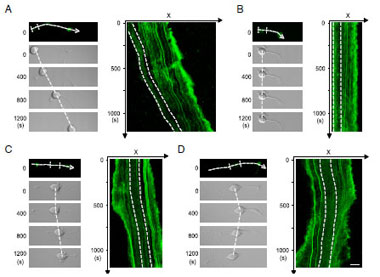8月11日,《神经科学杂志》(The Journal of Neuroscience)发表了中国科学院上海生命科学研究院神经科学研究所的研究成果:“迁移神经元中前导突起顶端通过促进肌动蛋白纤维向前流动驱动胞体迁移”。该项工作主要由何珉和张正洪等在袁小兵研究员指导下完成。
神经元迁移涉及细胞体和前导突起顶端的协同运动,然而细胞的不同部位,特别是突起顶端和细胞后方,在胞体运动中分别发挥怎样的作用仍然有待阐述。何珉及其同事通过局部灌流干扰细胞骨架成分的方法研究了神经元迁移的动力原理。他们发现与不迁移的神经元相比,迁移神经元前导突起顶端的生长锥样结构更加活跃,切除生长锥或抑制生长锥动态都会抑制胞体的迁移。局部破坏引导突起中间的肌动蛋白纤维也会阻止胞体的迁移,而破坏引导突起中间或胞体处的微管会加速胞体的运动。在转入GFP-alpha-actinin 的神经元中,利用荧光斑点成像技术(Fluorescent speckle microscopy, FSM)观察到伴随胞体向前运动,前导突起中存在肌动蛋白纤维向前方的流动。进而发现肌动蛋白纤维的流动对胞体运动是必需的,且肌动蛋白纤维的流动有赖于细胞内肌球蛋白前高后低的活性分布。这项研究表明,迁移神经元中前导突起顶端通过肌球蛋白介导的肌动蛋白纤维流动活跃的拉动胞体向前运动。
该工作得到了中国科学院、国家科技部、自然科学基金委的资助。
推荐原文出处:
The Journal of Neuroscience doi:10.1523/JNEUROSCI.0240-10.2010
Leading Tip Drives Soma Translocation via Forward F-Actin Flow during Neuronal Migration
Min He,1,2 Zheng-hong Zhang,1 Chen-bing Guan,1 Di Xia,1 and Xiao-bing Yuan1
1Institute of Neuroscience and State Key Laboratory of Neuroscience, Shanghai Institutes for Biological Sciences, Chinese Academy of Sciences, Shanghai 200031, China, and 2Graduate School of the Chinese Academy of Sciences, Shanghai 200031, China
Neuronal migration involves coordinated extension of the leading process and translocation of the soma, but the relative contribution of different subcellular regions, including the leading process and cell rear, in driving soma translocation remains unclear. By local manipulation of cytoskeletal components in restricted regions of cultured neurons, we examined the molecular machinery underlying the generation of traction force for soma translocation during neuronal migration. In actively migrating cerebellar granule cells in culture, a growth cone (GC)-like structure at the leading tip exhibits high dynamics, and severing the tip or disrupting its dynamics suppressed soma translocation within minutes. Soma translocation was also suppressed by local disruption of F-actin along the leading process but not at the soma, whereas disrupting microtubules along the leading process or at the soma accelerated soma translocation. Fluorescent speckle microscopy using GFP--actinin showed that a forward F-actin flow along the leading process correlated with and was required for soma translocation, and such F-actin flow depended on myosin II activity. In migrating neurons, myosin II activity was high at the leading tip but low at the soma, and increasing or decreasing this front-to-rear difference accelerated or impeded soma advance. Thus, the tip of the leading process actively pulls the soma forward during neuronal migration through a myosin II-dependent forward F-actin flow along the leading process.








